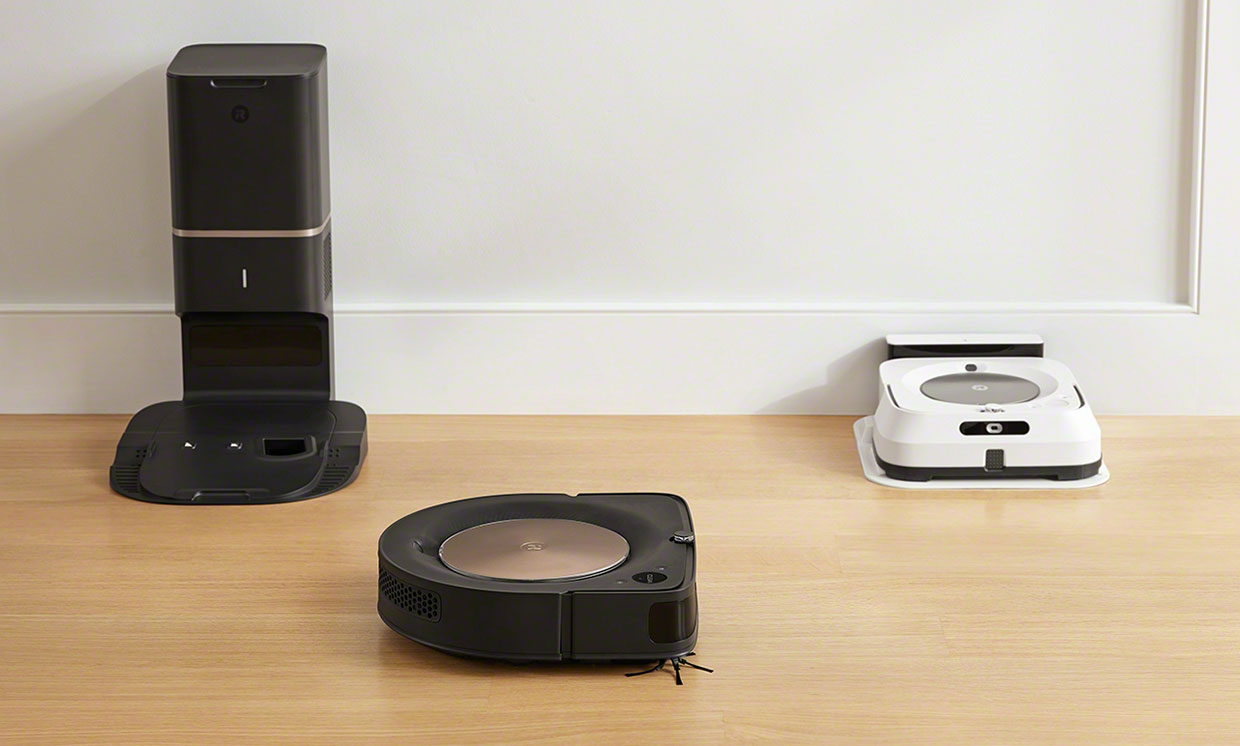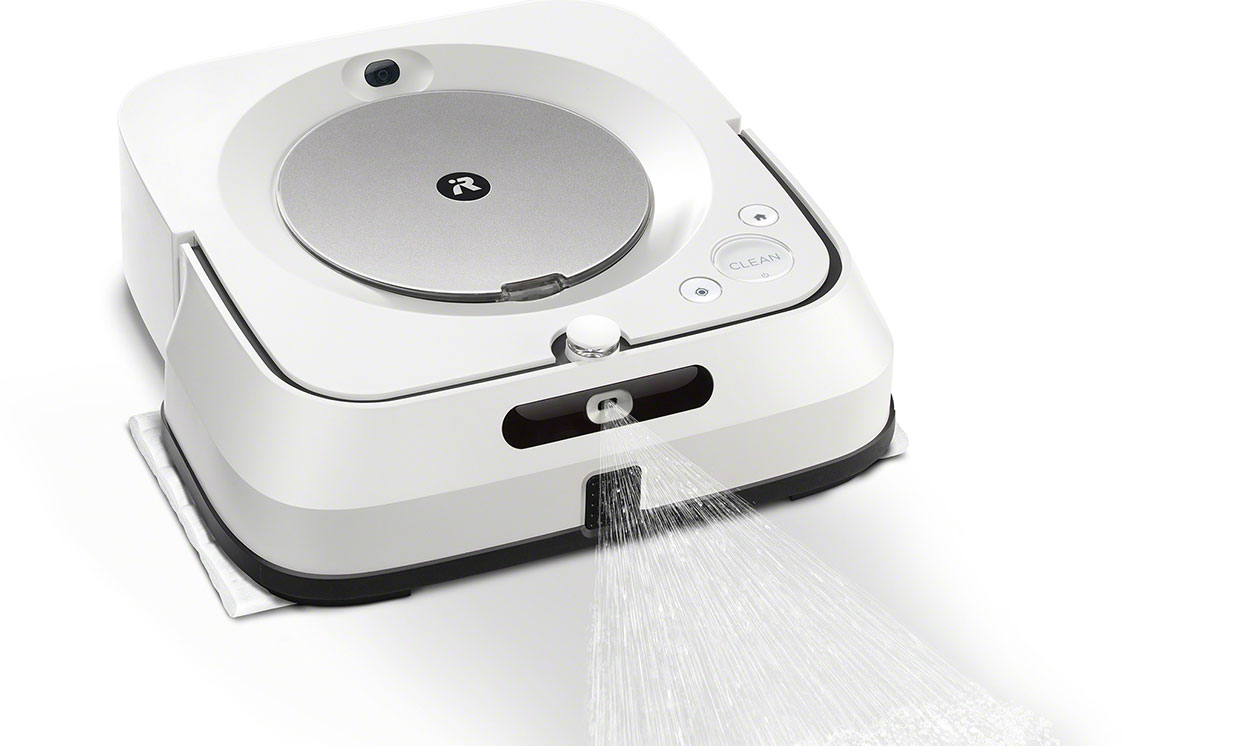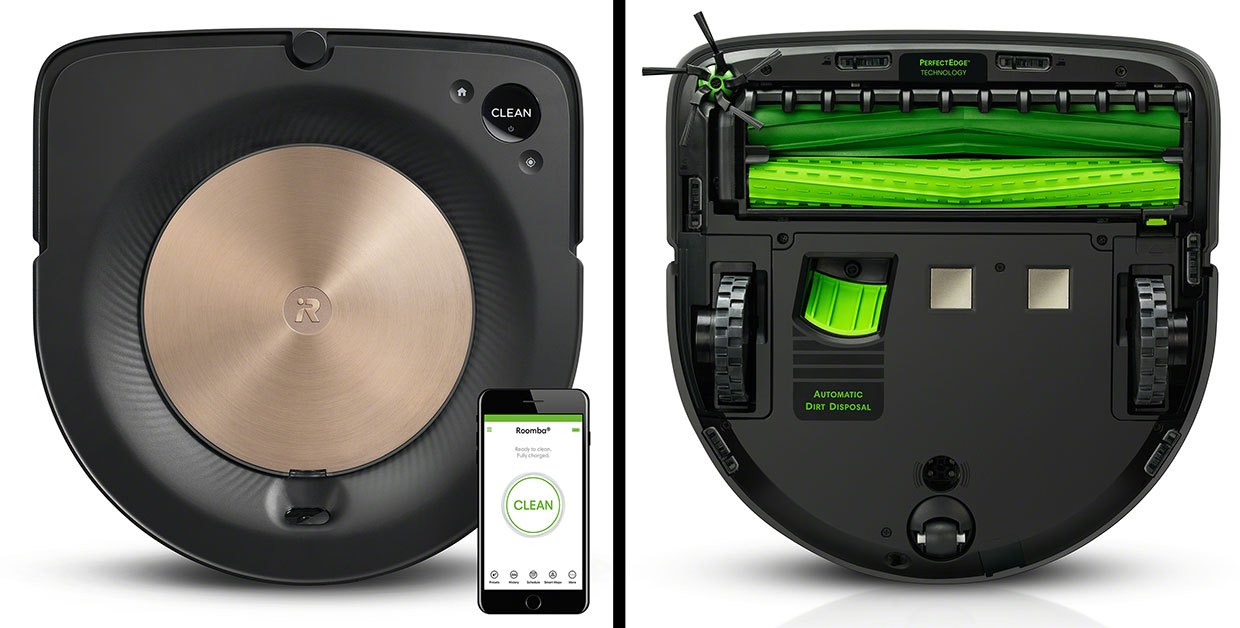iRobot Completely Redesigns Its Floor Care Robots With New m6 and s9
iRobot Roomba s9
Until today, I never thought I’d see a square-fronted Roomba, but here we are. We’re told that the Roomba s9 is basically “a ground-up redesign” of the Roomba. And while there are a lot of features that trace their heritage to earlier Roomba generations, iRobot didn’t leave all that much untouched. You still get a little bit of that older Roomba look with the very prominent round design on top (which is also a light ring for notifications and provides top access to the dust bin), but otherwise, square-ish is the new round.
For years, Neato has made the point that in order to get deep into corners and up along all the flat surfaces that can be found in most homes, a square front makes the most sense. Roombas have had the advantage in maneuverability (since a round design allows for zero-radius turns), but it looks like iRobot has decided that the square front really does clean better.
Having a square front gives the Roomba s9 a few different advantages. First, it means that the cleaning system (the brushes and vacuum) are 30% wider than they could be otherwise, and they get closer to the edges of the robot. Second, and far more excitingly, the square front gives iRobot the space it needs to install a 3D time-of-flight sensor. The press release describes this as “a new advanced 3D sensor [that] constantly scans what’s immediately ahead of the Roomba s9+ at a rate of 25 times per second to help the robot get deep into corners, along edges and clean large areas efficiently.”
Despite repeated pestering, iRobot wouldn’t tell us exactly what the 3D sensor is. What we do know is that it provides x, y, and z coordinates of obstacles, and is robust to the kinds of black or reflective surfaces that have historically tripped up iRobot’s front proximity sensors. (If your Roomba has repeatedly smashed itself into pieces of black furniture, you know exactly what I’m talking about.) iRobot says that the sensor helps “make the process of touching stuff more elegant.” The robot will still nudge things to tell exactly how close it is to obstacles, but it should do so much more gently. The sensor will also help the robot get into tighter spaces, navigate cleanly through those spaces, and then get out again, despite its square shape. And we’re also told that over-the-air updates will add more capability via this sensor in the future.
The front sensor also helps the Roomba s9 make more accurate maps, although the primary mapping system is still the same upward facing vSLAM camera that you’ll find on the i7. It’s exactly the same, in fact, and the Braava m6 uses it as well.
iRobot Braava m6
The Braava traces its lineage back to Mint, a little Swiffer-ish robot developed by Evolution Robotics nearly a decade ago; I reviewed one back in 2010. iRobot acquired Evolution Robotics in 2012, and adopted the idea of using disposable or reusable cleaning pads rather than the time consuming and often rather messy wet floor cleaning system of iRobot’s own Scooba. The Braava Jet (announced in 2016) was a compromise, using both sprayed water and cleaning pads, and the m6 is essentially the same—except bigger, easier to use, and able to map its environment just like the Roomba i7 and s9.
The m6 can use dry cleaning pads if you want, but it’s really designed to be a mopping robot, cleaning your floors with tap water (or cleaning solution). You fill up a tank onboard the robot, and it squirts water in front of it as it cleans, careful not to get baseboards or obstacles unnecessarily wet. Unlike a vacuum, where one powerful pass is usually sufficient, you can instruct the Braava to make anywhere from 1 to 5 passes over your entire floor, depending on how sticky things have gotten. You can select the amount of water that it uses, too: more is fine for tile, but you might want less for fancy hardwood. Once the Braava is done, it’ll autonomously return to its charging dock just like a Roomba, although you’ll need to add more water to the tank and change out the pad, which involves a single button to drop a disposable pad into the trash, or a reusable pad into the washing machine.
Robot Teamwork

The Roomba s9, Braava m6, and the Roomba i7 are all equipped with what iRobot is calling “Imprint Link Technology.” For the moment, this enables the robots to do just one big thing: collaborate on a floor cleaning sequence. The same interface within the iRobot app that shows you a robot-generated floor map of your home allows you to select whatever room or combination of rooms you want the robots to clean. First, the Roomba will vacuum your floors in nice straight lines, and then the Braava will follow, in equally nice (but slightly more damp) straight lines of its own. The coverage is efficient and can be done without you paying any attention at all, or even being at home. Doing things this way should help both robots clean significantly better. The Braava will be happier not having to deal with large debris (which its pad isn’t designed for), while the Roomba won’t have to try and handle sticky floors.
This teamwork idea is a big deal for home robots, and it’s clear that this initial cooperative functionality is just the beginning. We asked iRobot CEO Colin Angle about this, along with some other questions to help put these new robots in context.
IEEE Spectrum: Now that different robots in the home specialized in different tasks can communicate with each other, there must be an enormous amount of potential, right?
Colin Angle: Absolutely. Now that we have an understanding of where rooms are, you now have a framework to collaborate around, and instead of just vacuuming the home, we’re now cleaning the home: vacuum these rooms, mop those rooms, and vacuum and then mop those other rooms. And those actions can be triggered by other devices connected to the home ecosystem.
One example is: Today, if you’re cleaning the kitchen after serving a meal, there’s this visceral experience around when you turn on the dishwasher— the moment when everything is clean and stress goes down. Well, why not mop then, too? Why not have these home rituals augmented with robotic collaboration. It’s a very, very rich space, and we’re just scratching the surface, but the door has been opened because of the ability to remember maps, understand the home, and now, starting to have real inter-robot collaboration.
Is there anything more you can tell us about the new 3D sensor?
It’s a structured light sensor that’s used to give us a 3D reconstruction of the environment in front of the robot. That’s useful to make sure that we don’t bump anything more aggressively than we want to by design. If you look at the trajectory that the robot takes as it sort of swoops in along the edge of a room, or lines itself up to drive along a baseboard, you’ll see real precision— the s9 is literally millimeters away from baseboards as it cleans. The sensor is also used to help the robot navigate around things like chair legs and underneath tables much more thoughtfully and effectively, since we can actually see where obstacles are and aim between them.
Are there other capabilities that this sensor could be leveraged for in the future?
The s9 is a platform, just to be clear. Launch features and the features a year from now— we’ll be continually updating the software to improve the performance. One idea is that the robot could actually recognize the type of objects it’s cleaning around, and have object specific behaviors to help it do a better job and not get stuck. We have some basic functionality in that category today, but it will certainly be something that we will continue to develop, and it’ll get better and better. The goal with the s9 is a big jump in cleaning with the ability to deliver an experience where you can go months without touching your robot, so there’s suddenly such a huge benefit to not getting stuck. Really, we want the robot living in your home, giving you this frictionless experience of having your home completely and thoroughly vacuumed every single day.
Why did you decide to update the Braava for mopping, rather than bringing back the Scooba?
The Scooba did a great job cleaning, but the user experience, unfortunately, wasn’t what it could have been. The problem was that you had to clean Scooba up after every use. The promise of robot mopping, like the promise of robot vacuuming, is that you just let the robot do it, and Scooba still required you to get a little wet and dirty. The Braava Jet architecture was much more well-received by consumers, because you could just use the disposable or washable pad, and the cleanup is radically easier. One day I’d love auto-replenishment of Braava, but that’s a ways off.

With our floors now autonomously vacuumed and mopped almost entirely autonomously, what other opportunities are there for iRobot to innovate in the home?
Well, you know about our little project for the lawn, so that’s definitely a next thing. And something I’m super excited about is, I view the i7 and the s9 as some of the first true smart home devices, where the experience when coupled with something like a smart speaker, and home understanding, delivers a home experience that’s much richer than “turn on the light,” and feels more like a service than a product. You have deep cleaning every day, on-demand ‘clean up that mess…’ How do we make more of the smart home feel the same way?
So if you think about iRobot’s ‘what’s-next’ future, it’s a lot about enabling the smart home to actually be smart, to be more about delivering to the owner a healthier, well maintained environment, than it is about just convenience. And creating a way that finally, after a decade of hype, the smart home actually starts to deliver. I can’t get more specific about it at this point, but that’s the journey that we’re on.
If you thought the i7+ was a “top of the line” robot vacuum (which is totally what we thought up until just now), you’d be wrong. According to iRobot, “the i7 represents the upper end of our middle tier,” while the s9 is “premium tier.” This seems like it could be a bit of a disappointment for anyone who recently spent around US $1,000 on what was, for a few months anyway, arguably the best robot vacuum out there. But if it makes you feel any better, the s9+ (with the dirt dock) will cost a staggering $1,299 when it goes on sale on 9 June. The m6 is more reasonable, retailing for $499 with its charging dock included.
For Roomba i7 early adopters, we should reiterate that the i7 does communicate with the m6, which allows you to take advantage of the tag-team vacuuming and mopping behavior. Unfortunately, the s9 does not work with the i7’s dirt dock, which, honestly, is a bit irritating. iRobot told us that it’s because the position of the bin in the s9 is different and so the access port has to be in a different place, and also that there are different electronics inside the base to help the s9 charge faster.

Whenever we post about these super fancy Roombas, we try to keep things in context by pointing out that earlier generations (you know, the round ones) do a totally decent job of cleaning floors, even if they don’t make maps or get the dirt automatically sucked out of them. If you just want a robot to vacuum your floors, a Roomba that costs a third of the price of the s9 will probably clean your house almost as well, albeit with a little bit more effort on your part.
Also, with the s9 specifically, the most exciting thing (we think) is that 3D sensor on the front, which is probably capable of doing more for iRobot gadgets than it’s currently being using for. The inter-robot communication thing is a big deal too; there are lots of ways that we can imagine robots being able to integrate more usefully into our lives. But they’re not there yet, and it’s perfectly reasonable to say, okay, let’s wait see what iRobot manages to do with this new technology over the next six months or a year before dropping nearly $2,000 on a new team of floor cleaning robots. Besides, at this rate, they’ll have a newer and way fancier robot out by then anyway. My guess? An anti-gravity system to go up and down stairs, lasers to zap pollen right out of the air, and an inertial agitation system that gently shakes your entire house to loosen up even the most stubborn clumps of dirt.
[ iRobot ]

Leave a Reply